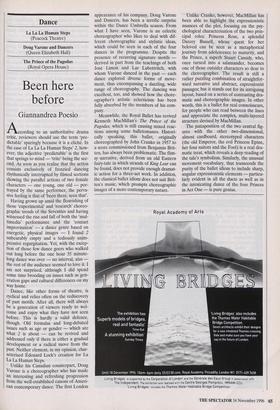Dance
La La La Human Steps (Peacock Theatre) Doug Varone and Dancers (Queen Elizabeth Hall) The Prince of the Pagodas (Royal Opera House)
Been here before
thannandrea Poem
According to an authoritative drama critic, reviewers should use the term 'pre- dictable' sparingly because it is a cliché. In the case of La La La Human Steps' 2, how- ever, the adjective 'predictable' is the first that springs to mind — 'trite' being the sec- ond. As soon as you realise that the action consists exclusively of frenzied dancing rhythmically interrupted by filmed sections showing the parallel actions of two female characters — one young, one old — por- trayed by the same performer, the perva- sive feeling is that of 'been there, seen that'.
Having grown up amid the flourishing of those 'experimental' and 'research' choreo- graphic trends of the Seventies and having witnessed the rise and fall of both the 'mul- timedia' performance and the 'contact improvisation' — a dance genre based on energetic, physical images — I found 2 unbearably empty and a tediously unim- pressive regurgitation. Yet, with the excep- tion of those few dance goers who walked out long before the one hour 35 minute- long dance was over — no interval, alas the rest of the audience seemed to love it. I am not surprised, although I did spend some time brooding on issues such as gen- eration gaps and cultural differences on my way home.
Dance, like other forms of theatre, is cyclical and relies often on the rediscovery of past motifs. After all, there will always be a generation of viewers ready to wel- come and enjoy what they have not seen before. This is hardly a valid defence, though. Old formulas and long-debated issues such as age or gender — which are what 2 is about — can be revived and addressed only if there is either a gradual development or a radical move from the past. Neither element, in my opinion, char- acterised Edouard Lock's creation for La La La Human Steps.
Unlike his Canadian counterpart, Doug Varone is a choreographer who has made an interesting and refreshing progression from the well-established canons of Ameri- can contemporary dance. The first London appearance of his company, Doug Varone and Dancers, has been a terrific surprise within the Dance Umbrella season. From what I have seen, Varone is an eclectic choreographer who likes to deal with dif- ferent choreographic and stylistic ideas, which could be seen in each of the four dances in the programme. Despite the presence of recurring signature motifs derived in part from the teachings of both Jos6 Limon and Lar Lubotivitch, with whom Varone danced in the past — each dance explored diverse forms of move- ment, thus encompassing a dazzling, wide range of choreography. The dancing was excellent, too, and showed how the chore- ographer's artistic eclecticism has been fully absorbed by the members of his com- pany.
Meanwhile, the Royal Ballet has revived Kenneth MacMillan's The Prince of the Pagodas, which is still causing mixed reac- tions among some balletomanes. Histori- cally speaking, this ballet, originally choreographed by John Cranko in 1957 to a score commissioned from Benjamin Brit- ten, has always been problematic. The flim- sy narrative, derived from an old Eastern fairy-tale in which strands of King Lear can be found, does not provide enough dramat- ic action for a three-act work. In addition, the classical ballet idiom does not suit Brit- ten's music, which prompts choreographic images of a more contemporary nature. Unlike Cranko, however, MacMillan has been able to highlight the expressionistic nuances of the plot, focusing on the psy- chological characterisation of the two prin- cipal roles: Princess Rose, a splendid Darcey Bussell, whose quest for her beloved can be seen as a metaphorical journey from adolescence to maturity, and the Prince, a superb Stuart Cassidy, who, once turned into a salamander, becomes one of those outsider characters so dear to the choreographer. The result is still a rather puzzling combination of straightfor- ward narrative and abstract, expressionist passages; but it stands out for its intriguing layout, based on a series of contrasting dra- matic and choreographic images. In other words, this is a ballet for real connoisseurs, for people who can read between the lines and appreciate the complex, multi-layered structure devised by MacMillan.
The juxtaposition of the two central fig- ures with the other two-dimensional, almost cardboard, stereotyped characters (the old Emperor, the evil Princess Epine, her four suitors and the Fool) is a real dra- matic treat, which reveals a deep reading of the tale's symbolism. Similarly, the unusual movement vocabulary, that transcends the purity of the ballet idiom to include sharp, angular expressionistic elements — particu- larly evident in all the duets as well as in the intoxicating dance of the four Princes in Act One — is pure genius.


















































































 Previous page
Previous page